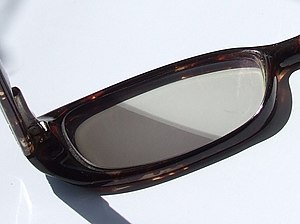
Photochemistry is the branch of chemistry concerned with the chemical effects of light. Generally, this term is used to describe a chemical reaction caused by absorption of ultraviolet, visible light (400–750 nm) or infrared radiation (750–2500 nm).

Azobenzene is a photoswitchable chemical compound composed of two phenyl rings linked by a N=N double bond. It is the simplest example of an aryl azo compound. The term 'azobenzene' or simply 'azo' is often used to refer to a wide class of similar compounds. These azo compounds are considered as derivatives of diazene (diimide), and are sometimes referred to as 'diazenes'. The diazenes absorb light strongly and are common dyes.
Diarylethene is the general name of a class of chemical compounds that have aromatic functional groups bonded to each end of a carbon–carbon double bond. The simplest example is stilbene, which has two geometric isomers, E and Z.
In chemistry, photoisomerization is a form of isomerization induced by photoexcitation. Both reversible and irreversible photoisomerizations are known for photoswitchable compounds. The term "photoisomerization" usually, however, refers to a reversible process.
In chemistry, chromism is a process that induces a change, often reversible, in the colors of compounds. In most cases, chromism is based on a change in the electron states of molecules, especially the π- or d-electron state, so this phenomenon is induced by various external stimuli which can alter the electron density of substances. It is known that there are many natural compounds that have chromism, and many artificial compounds with specific chromism have been synthesized to date. It is usually synonymous with chromotropism, the (reversible) change in color of a substance due to the physical and chemical properties of its ambient surrounding medium, such as temperature and pressure, light, solvent, and presence of ions and electrons.

Photosensitizers are light absorbers that alter the course of a photochemical reaction. They usually are catalysts. They can function by many mechanisms, sometimes they donate an electron to the substrate, sometimes they abstract a hydrogen atom from the substrate. At the end of this process, the photosensitizer returns to its ground state, where it remains chemically intact, poised to absorb more light. One branch of chemistry which frequently utilizes photosensitizers is polymer chemistry, using photosensitizers in reactions such as photopolymerization, photocrosslinking, and photodegradation. Photosensitizers are also used to generate prolonged excited electronic states in organic molecules with uses in photocatalysis, photon upconversion and photodynamic therapy. Generally, photosensitizers absorb electromagnetic radiation consisting of infrared radiation, visible light radiation, and ultraviolet radiation and transfer absorbed energy into neighboring molecules. This absorption of light is made possible by photosensitizers' large de-localized π-systems, which lowers the energy of HOMO and LUMO orbitals to promote photoexcitation. While many photosensitizers are organic or organometallic compounds, there are also examples of using semiconductor quantum dots as photosensitizers.
Ionochromism, similar to chromic methods such as photochromism, thermochromism and other chromism phenomena, is the reversible process of changing the color of a material by absorption or emission spectra of molecules using ions. Electrochromism is similar to ionochromism as it involves the use of electrons in order to change the color of materials. Both electrochromic and ionochromic materials undergo a change in color by the flow of charged particles, where electrochromic materials only involve an anionic species or negatively charged species such as electrons. An example of an ionochromic dye is a complexometric indicator. A complexometric indicator involves the presence of metal ions in order to facilitate color change and is often used in complexometric titration.

A leuco dye is a dye which can switch between two chemical forms, one of which is colorless. Reversible transformations can be caused by heat, light or pH, resulting in examples of thermochromism, photochromism and halochromism respectively. Irreversible transformations typically involve reduction or oxidation. The colorless form is sometimes referred to as the leuco form.
Solar chemical refers to a number of possible processes that harness solar energy by absorbing sunlight in a chemical reaction. The idea is conceptually similar to photosynthesis in plants, which converts solar energy into the chemical bonds of glucose molecules, but without using living organisms, which is why it is also called artificial photosynthesis.
A photoswitch is a type of molecule that can change its structural geometry and chemical properties upon irradiation with electromagnetic radiation. Although often used interchangeably with the term molecular machine, a switch does not perform work upon a change in its shape whereas a machine does. However, photochromic compounds are the necessary building blocks for light driven molecular motors and machines. Upon irradiation with light, photoisomerization about double bonds in the molecule can lead to changes in the cis- or trans- configuration. These photochromic molecules are being considered for a range of applications.

A photochromic lens is an optical lens that darkens on exposure to light of sufficiently high frequency, most commonly ultraviolet (UV) radiation. In the absence of activating light, the lenses return to their clear state. Photochromic lenses may be made of polycarbonate, or another plastic. Glass lenses use visible light to darken. They are principally used in glasses that are dark in bright sunlight, but clear, or more rarely, lightly tinted in low ambient light conditions. They darken significantly within about a minute of exposure to bright light and take somewhat longer to clear. A range of clear and dark transmittances is available.

3D optical data storage is any form of optical data storage in which information can be recorded or read with three-dimensional resolution.
A molecular switch is a molecule that can be reversibly shifted between two or more stable states. The molecules may be shifted between the states in response to environmental stimuli, such as changes in pH, light, temperature, an electric current, microenvironment, or in the presence of ions and other ligands. In some cases, a combination of stimuli is required. The oldest forms of synthetic molecular switches are pH indicators, which display distinct colors as a function of pH. Currently synthetic molecular switches are of interest in the field of nanotechnology for application in molecular computers or responsive drug delivery systems. Molecular switches are also important in biology because many biological functions are based on it, for instance allosteric regulation and vision. They are also one of the simplest examples of molecular machines.
The photostationary state of a reversible photochemical reaction is the equilibrium chemical composition under a specific kind of electromagnetic irradiation.

Stefan Hecht is a German chemist.
Photoelectrochemical processes are processes in photoelectrochemistry; they usually involve transforming light into other forms of energy. These processes apply to photochemistry, optically pumped lasers, sensitized solar cells, luminescence, and photochromism.
A spiropyran is a type of organic chemical compound, known for photochromic properties that provide this molecule with the ability of being used in medical and technological areas. Spiropyrans were discovered in the early twentieth century. However, it was in the middle twenties when Fisher and Hirshbergin observed their photochromic characteristics and reversible reaction. In 1952, Fisher and co-workers announced for the first time photochromism in spiropyrans. Since then, there have been many studies on photochromic compounds that have continued up to the present.

Photoactivated peptides are modified natural or synthetic peptides the functions of which can be activated with light. This can be done either irreversibly or in a reversible way. Caged peptides which contain photocleavable protecting groups belong to irreversibly activated peptides. Reversible activation/deactivation of peptide function are achieved by incorporation photo-controllable fragments in the side chains or in the backbone of peptide templates to get the photo-controlled peptides, which can reversibly change their structure upon irradiation with light of different wavelength. As the consequence, the properties, function and biological activity of the modified peptides can be controlled by light. Since light can be directed to specific areas, such peptides can be activated only at targeted sites. Azobenzenes, and diarylethenes can be used as the photoswitches. For therapeutic use, photoswitches with longer wavelengths or the use of two-photon excitation are required, coupled with improved methods for peptide delivery to live cells.

Quasi-crystals are supramolecular aggregates exhibiting both crystalline (solid) properties as well as amorphous, liquid-like properties.

In organic chemistry, a fulgide is any of a class of photochromic compounds consisting of a bismethylene-succinic anhydride core that has an aromatic group as a substituent. The highly conjugated system is a good chromophore. It can undergo reversible photoisomerization induced by ultraviolet light, converting between the E and Z isomers, both of which are typically colorless compounds. Unlike the more-stable Z isomer, the E isomer can also undergo a photochemically-induced electrocyclic reaction, forming a new ring and becoming a distinctly colored product called the C form. It is thus the two-step Z–C isomerization that is the photochromic change starting from the stable uncyclized form.













